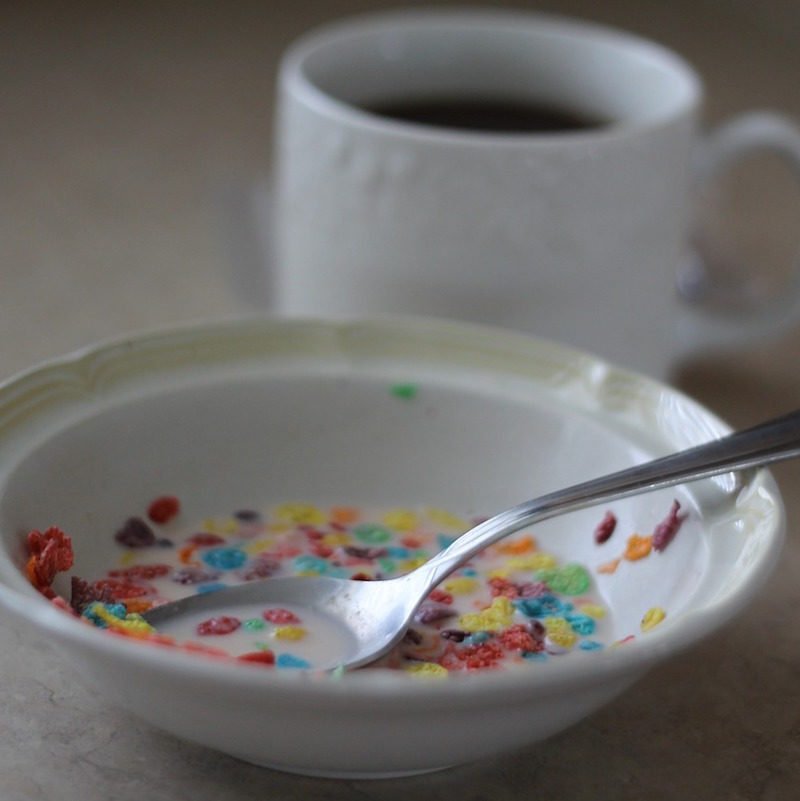 I grew up eating cold cereal. Cheerios, Corn Flakes and Rice Krispies were the day-to-day staples, but Apple Jacks, Froot Loops, Lucky Charms and Sugar Snaps (these I did not like) made regular appearances, too. In my middle school years, I remember having a special fondness for Cookie Crisp and the now-defunct Waffelos. In college I decided to be healthier and went for the Raisin Bran with some Grape Nuts for extra crunch.
I grew up eating cold cereal. Cheerios, Corn Flakes and Rice Krispies were the day-to-day staples, but Apple Jacks, Froot Loops, Lucky Charms and Sugar Snaps (these I did not like) made regular appearances, too. In my middle school years, I remember having a special fondness for Cookie Crisp and the now-defunct Waffelos. In college I decided to be healthier and went for the Raisin Bran with some Grape Nuts for extra crunch.
The last time I regularly ate cold cereal was in 2007 when I was training for a (walking) half-marathon as soon as I recovered from a spectacularly broken ankle. I found that a small bowl of Kashi’s Autumn Wheat (kind of like Shredded Wheat) or Go Lean Crunch with half a banana and milk made an acceptable light breakfast before some of my longer training walks.
Which Part of A Complete Breakfast?
Then I started to realize that, despite Kashi’s health halo, that cold cereal just wasn’t all that. I had a brief flirtation with Trader Joe’s High Fiber Fruit & Nut Multigrain Medley, but found that most of the box would go stale because we just weren’t eating it.
Why? Because I feel like cold cereal (with the exception of some high-quality granolas) is a good example of “there’s no food in that food.” I remember, even as a child, puzzling over the TV cereal ads that proclaimed that their product was “part of a complete breakfast.” Many of the ads showed a huge bowl of cereal along side a few slices of buttered white toast, a big glass of orange juice and a bigger glass of milk. At the time, I simply thought, “Who eats toast with their cereal?” (In our house, it was one or the other, not both.) Today I simply think, “What a carb bomb!”
Robbing the Goodness From Grains
Speaking of bombs, my main reason for shunning cold cereal forever more is the way they are produced. Namely, in extrusion machines that rip apart sugar, starch and protein molecules under extreme heat and pressure (a process referred to as “plasticization”) then shoot them out into various puffed shapes before they are coated with synthetic vitamins. This industrial production kills off any natural flavor or color, so synthetic version of those are added as well. Yum!
As Melanie Warner puts it in Pandora’s Lunchbox, “Extrusion is undoubtedly the harshest and most nutritionally devastating way to process cereal.”
So not only is it a carb bomb that’s likely to spike your blood sugar then leave you tired and hungry and hour later, but it’s void of natural vitamins, flavor and color. In other words, you might as well spray the box it comes in with vitamins and eat that! When a patient tells me they eat cold cereal, milk (or almond milk, which has almost no protein) and fruit for breakfast, the first thing I ask them is how soon after breakfast they get hungry again.
We Can Do Better than Doughnuts…Or Cold Cereal
One of the first attacks on boxed cereal as a source of “empty calories” was met by this defense from the cereal industry: they’re better than a doughnut. (While that might be true for SOME cold cereals—whereas for others perhaps not—is this really the best we can do.)
Unfortunately, the “better-than-a-doughnut” defense has been used by some nutrition experts, including this 2009 quote in the New York Times from Eileen Kennedy, former dean of the Tufts University School of Nutrition:
“You’re rushing around, you’re trying to think about healthy eating for your kids and you have a choice between a doughnut and a cereal,” Dr. Kennedy said, evoking a hypothetical parent in the supermarket. “So Froot Loops is a better choice.”
Well, this nutrition expert says you can do better than a donut…or Froot Loops for that matter!






